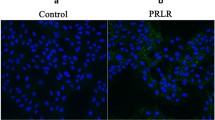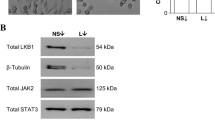Abstract
The protein synthesis inhibitor cycloheximide (Chx) suppresses prolactin-induced β-casein gene expression in the mammary epithelial cell line COMMA-D. As the mechanism underlying this effect is unclear, the effects of protein synthesis inhibitors on interactions of transcription factors with the β-casein promoter were examined. Suppression of prolactin-induced β-casein gene expression occurred in both COMMA-D cells and primary mammary cell cultures with as little as 2 h protein synthesis inhibition. This was associated with changes in transcription factors interacting at a response element in the proximal region of the rat β-casein promoter. Inhibition of protein synthesis was associated with NF-κB binding at a site immediately 3' to the Stat5-binding site at position 97–89 of the β-casein promoter, suppression of Stat5 DNA-binding activity, and inhibition of Stat5 tyrosine phosphorylation. Treatment with the NF-κB inhibitor parthenolide failed to restore prolactin responsiveness. These results show that protein synthesis inhibition is associated with both blockage of prolactin-Stat5 signaling and NF-κB binding to the β-casein promoter, but that the latter is not necessary for the suppression of β-casein expression.







Similar content being viewed by others
References
Altiok S, Groner B (1994) Beta-casein mRNA sequesters a single stranded nucleic acid-binding protein which negatively regulates the β-casein promoter. Mol Cell Biol 14:6004–6012
Baldwin ASJ (1996) The NF-κB and IκB proteins: new discoveries and insights. Annu Rev Immunol 14:649–681
Beaton A, Wilkins RJ, Wheeler TT (1997) Lactation-associated and prolactin-responsive changes in protein synthesis in mouse mammary cells. Tissue Cell 29:509–516
Bennett BL, Cruz R, Lacson RG, Manning AM (1997) Interleukin-4 suppression of tumor necrosis factor alpha-stimulated E-selectin gene transcription is mediated by Stat6 antagonism of NF-κB. J Biol Chem 272:10212–10219
Brantley DM, Yull FE, Muraoka RS, Hicks DJ, Cook CM, Kerr LD (2000) Dynamic expression and activity of NF-κB during post-natal mammary gland morphogenesis. Mech Dev 97:149–155
Clarkson RW, Heeley JL, Chapman R, Aillet F, Hay RT, Wyllie A, Watson CJ (2000) NF-κB inhibits apoptosis in murine mammary cells. J Biol Chem 275:12737–12742
Danielson KG, Oborn CJ, Durban EM, Butel JS, Medina D (1984) Epithelial mouse mammary cell line exhibiting normal morphogenesis in vivo and functional differentiation in vitro. Proc Natl Acad Sci USA 81:3756–3760
Doppler W, Welter T, Philipp S (1995) CCAAT/enhancer binding protein isoforms b and d are expressed in mammary epithelial cells and bind to multiple sites in the beta-casein gene promoter. J Biol Chem 270:17962–17969
Geymayer S, Doppler W (2000) Activation of NF-κB p50/p65 is regulated in the developing mammary gland and inhibits Stat5-mediated beta-casein gene expression. FASEB J 14:1159–1170
Ihle J (1996) STATs: signal transducers and activators of transcription. Cell 84:331–334
Kazansky AV, Raught B, Lindsey SM, Wang Y-F, Rosen JM (1995) Regulation of mammary gland factor/Stat5a during mammary gland development. Mol Endocrinol 9:1598–1609
Laemmli UK (1970) Cleavage of structural proteins during the assembly of the head of bacteriophage T4. Nature 227:680–685
Li S, Rosen JM (1995) Nuclear factor I and mammary gland factor (STAT5) play a critical role in regulating rat whey acidic protein gene expression in transgenic mice. Mol Cell Biol 15:2063–2070
Liu X, Robinson GW, Hennighausen L (1996) Activation of Stat5a and Sta5b by tyrosine phosphorylation is tightly linked to mammary gland diferentiation. Mol Endocrinol 10:1496–1506
Liu X, Robinson GW, Wagner K-U, Garrett L, Wynshaw-Boris A, Hennighausen L (1997) Stat5a is mandatory for adult mammary gland development and lactogenesis. Gene Dev 11:179–186
Luo G, Yu-Lee L (2000) Stat5 inhibits NF-kappaB-mediated signaling. Mol Endocrinol 14:114–123
Meier V, Groner B (1994) The nuclear factor YY1 participates in repression of the beta-casein promoter in mammary epithelial cells and is counteracted by mammary gland factor during lactogenic hormone induction. Mol Cell Biol 14:128–137
Messner B, Stutz AM, Albrecht B, Peiritsch S, Woisetschlager M (1997) Cooperation of binding sites for Stat6 and NF-κB/Rel in the IL-4-induced up-regulation of the human IgE germline promoter. J Immunol 22:3330–3337
Nakshatri H, Bhat-Nakshatri P, Martin DA, Goulet RJJ, Sledge GWJ (1997) Constitutive activation of NF-κB during progression of breast cancer to hormone-independent growth. Mol Cell Biol 17:3629–3639
Newton R, Adock IM, Barnes PJ (1996) Superinduction of NF-κB by actinomycin D and cycloheximide in epithelial cells. Biochem Biophys Res Commun 218:518–523
Poyet P, Henning SJ, Rosen JM (1989) Hormone-dependent beta-casein mRNA stabilization requires ongoing protein synthesis. Mol Endocrinol 3:1961–1968
Raught B, Liao WS, Rosen JM (1995) Developmentally and hormonally regulated CCAAT/enhancer binding protein isoforms influence beta-casein gene expression. Mol Endocrinol 9:1223–1232
Sadowski HB, Gilman MZ, et al (1983) A common nuclear signal transduction pathway activated by growth factor and cytokine receptors. Science 261:1739–1744
Schindler C, Darnell JE (1995) Transcriptional responses to polypeptide ligands: the JAK-STAT pathway. Annu Rev Biochem 64:621–651
Schmitt-Ney M, Happ B, Ball RK, Groner B (1992a) Developmental and environmental regulation of a mammary gland-specific nuclear factor essential for transcription of the gene encoding beta-casein. Proc Natl Acad Sci USA 89:3130–3134
Schmitt-Ney M, Happ B, Hofer P, Hynes NE, Groner B (1992b) A mammary gland-specific nuclear factor activity is positively regulated by lactogenic hormones and negatively regulated by milk stasis. Mol Endocrinol 6:1988–1997
Shea-Eaton WK, Lee PP, Ip MM (2001) Regulation of milk protein gene expression in normal mammary epithelial cells by tumor necrosis factor. Endocrinology 142:2558–2568
Storz P, Doeppler A, Pfizenmaier K, Mueller G (1998) TNF inhibits insulin induced STAT5 activation in differentiated mouse muscle cells pmi28. FEBS Lett 440:41–45
Teglund S, McKay C, Schuetz E, Deursen JM van, Stravopodis D, Wang D, Brown M, Bodner S, Grosveld G, Ihle JN (1998) Stat5a and Stat5b proteins have essential and nonessential, or redundant, roles in cytokine responses. Cell 93:841–850
Wakao H, Gouilleux F, Groner B (1994) Mammary gland factor (MGF) is a novel member of the cytokine regulated transcription factor gene family and confers the lactogenic response. EMBO J 13:2182–2191
Wheeler TT, Kuys YM, Broadhurst M, Molenaar A (1997) Mammary Stat5 abundance and activity are not altered with lactation state in cows. Mol Cell Endocrinol 133:141–149
Wheeler TT, Broadhurst MK, Sadowski HB, Farr VC, Prosser CG (2001) Stat5 phosphorylation status and DNA-binding activity in the bovine and murine mammary glands. Mol Cell Endocrinol 176:39–48
Yoshimura M, Oka T (1990) Hormonal induction of β-casein gene expression: requirement for ongoing protein synthesis for transcription. Endocrinol 126:427–433
Zhang Z, Fuller GM (1997) The competitive binding of Stat3 and NF-κB on an overlapping DNA binding site. Biochem Biophys Res Commun 237:90–94
Author information
Authors and Affiliations
Corresponding author
Rights and permissions
About this article
Cite this article
Beaton, A., Broadhurst, M.K., Wilkins, R.J. et al. Suppression of β-casein gene expression by inhibition of protein synthesis in mouse mammary epithelial cells is associated with stimulation of NF-κB activity and blockage of prolactin-Stat5 signaling. Cell Tissue Res 311, 207–215 (2003). https://doi.org/10.1007/s00441-002-0672-2
Received:
Accepted:
Published:
Issue Date:
DOI: https://doi.org/10.1007/s00441-002-0672-2




